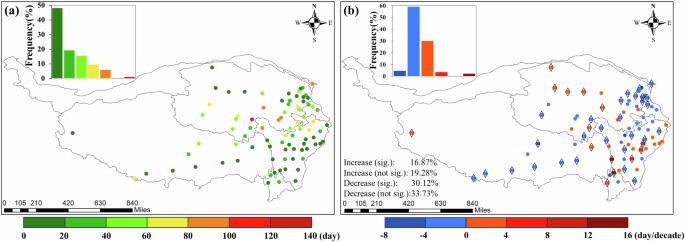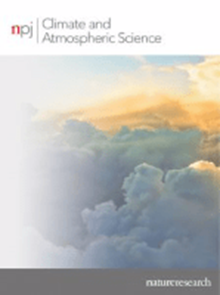描述青藏高原雪盖时间不连续性的新指数
IF 8.5
1区 地球科学
Q1 METEOROLOGY & ATMOSPHERIC SCIENCES
引用次数: 0
摘要
青藏高原的积雪对中国和东亚的气候、水文和生态有重大影响。目前的研究主要使用积雪覆盖日来描述积雪覆盖的持续时间,忽略了积雪的非连续性。本研究分析了1961-2019年青藏高原的积雪物候和连续积雪事件的时空分布。研究结果表明,与积雪覆盖天数相比,连续积雪覆盖天数能更好地反映积雪覆盖的时间不连续性。与北美、欧洲、东北和中国新疆等地区相比,其贡献率和连续性都较低,表明青藏高原的积雪覆盖连续性较差。此外,我们还发现气温和降水,尤其是秋季气温和春季及冬季降水,对各种积雪指数有显著影响。风速对积雪覆盖也有很大影响,尤其是在秋季。大气环流通过影响温度和降水间接影响积雪覆盖的不连续性。本文章由计算机程序翻译,如有差异,请以英文原文为准。


The new indices to describe temporal discontinuity of snow cover on the Qinghai-Tibet Plateau
Snow cover on the Qinghai-Tibet Plateau significantly impacts the climate, hydrology, and ecology of China and East Asia. Current studies mainly use snow cover days to describe its duration, overlooking the snow’s discontinuous nature. This study analyzes snow phenology and the spatiotemporal distribution of continuous snow cover events on the Qinghai-Tibet Plateau from 1961 to 2019. The findings indicate that continuous snow cover days better capture the temporal discontinuity of snow cover compared to snow cover days. The contribution and continuity are lower than regions like North America, Europe, Northeast and Xinjiang in China, indicating poorer snow cover continuity on the Qinghai-Tibet Plateau. Additionally, we found that temperature and precipitation, especially autumn temperatures and spring and winter precipitation, significantly impact various snow indices. Wind speed also significantly impacts snow cover, particularly in autumn. Atmospheric circulation indirectly affects the snow cover discontinuity by influencing temperature and precipitation.
求助全文
通过发布文献求助,成功后即可免费获取论文全文。
去求助
来源期刊

npj Climate and Atmospheric Science
Earth and Planetary Sciences-Atmospheric Science
CiteScore
8.80
自引率
3.30%
发文量
87
审稿时长
21 weeks
期刊介绍:
npj Climate and Atmospheric Science is an open-access journal encompassing the relevant physical, chemical, and biological aspects of atmospheric and climate science. The journal places particular emphasis on regional studies that unveil new insights into specific localities, including examinations of local atmospheric composition, such as aerosols.
The range of topics covered by the journal includes climate dynamics, climate variability, weather and climate prediction, climate change, ocean dynamics, weather extremes, air pollution, atmospheric chemistry (including aerosols), the hydrological cycle, and atmosphere–ocean and atmosphere–land interactions. The journal welcomes studies employing a diverse array of methods, including numerical and statistical modeling, the development and application of in situ observational techniques, remote sensing, and the development or evaluation of new reanalyses.
 求助内容:
求助内容: 应助结果提醒方式:
应助结果提醒方式:


